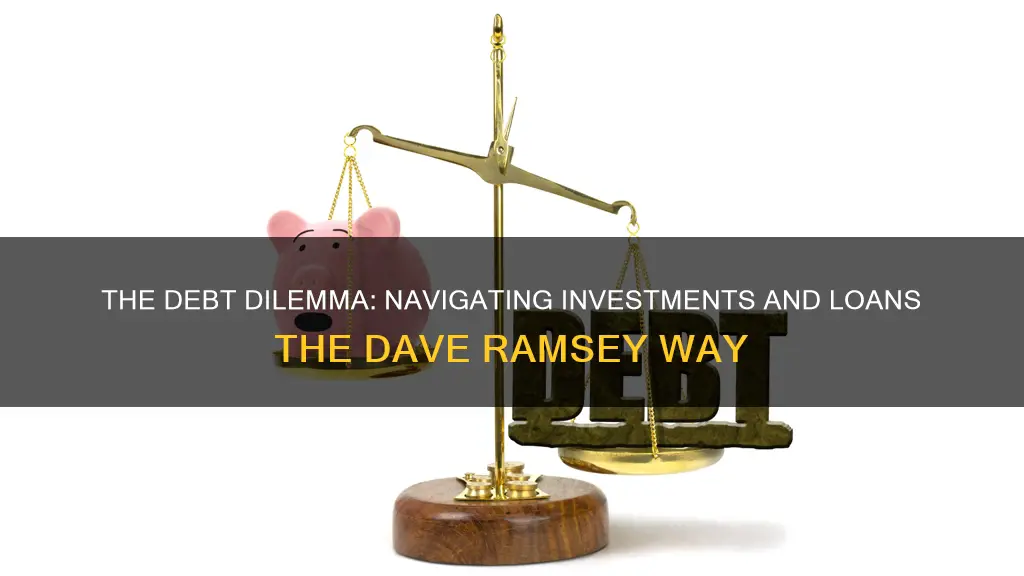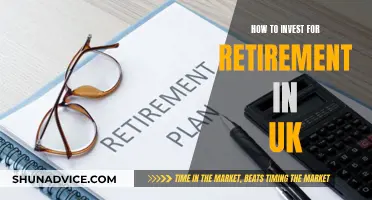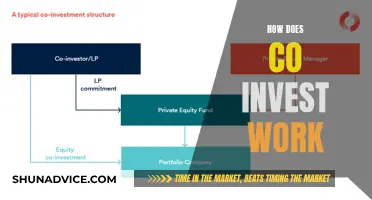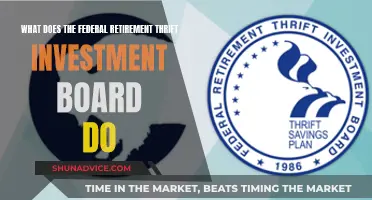
Personal finance expert Dave Ramsey advises people to pay off their debt before investing. In his seven baby steps plan, he recommends saving a small emergency fund, then paying off all debt except the mortgage, then building a larger emergency fund, and only then investing 15% of the household income in retirement. He argues that paying off debt first will allow people to free up [their] income and start building wealth faster. However, some critics argue that not everyone can free themselves of debt within a few years, and that foregoing the chance to earn an employer 401(k) match and tax breaks for investing can be shortsighted.
| Characteristics | Values |
|---|---|
| Priority | Paying off debt |
| Retirement savings | Save for retirement after paying off debt |
| Emergency fund | Save 3-6 months of expenses |
| Investment | Invest 15% of household income in retirement |
| College fund | Save for children's college fund |
| Mortgage | Pay off mortgage |
| Wealth | Build wealth and give |
What You'll Learn

The Baby Steps plan to paying off debt
The Baby Steps plan is a 7-step program designed by Dave Ramsey to help consumers save money, pay off debt, and build wealth. Here is a detailed breakdown of the 7 steps:
Baby Step 1: Save $1,000 for Your Starter Emergency Fund
The first step is to save $1,000 as fast as you can for unexpected life events. This will prevent you from digging a deeper hole while trying to work your way out of debt. You can save $1,000 by selling stuff, clipping coupons, saying no to extra expenses, planning your meals, eating out less, using or selling old gift cards, and downloading money-saving apps.
Baby Step 2: Pay Off All Debt (Except the House) Using the Debt Snowball
The second step is to pay off debts such as cars, credit cards, and student loans, except for your mortgage. List all your debts except for your mortgage and put them in order by balance from smallest to largest, regardless of interest rate. Pay the minimum payments on everything but the smallest one, and attack that one with a vengeance. Once it's gone, take that payment and put it toward the second-smallest debt, making minimum payments on the rest. This is called the debt snowball method, and you’ll use it to knock out your debts one by one.
Baby Step 3: Save 3–6 Months of Expenses in a Fully Funded Emergency Fund
The third step is to take the money you were throwing at your debt and build a fully funded emergency fund that covers 3–6 months of your expenses. This will protect you against life’s bigger surprises, like job loss or your car breaking down, without slipping back into debt.
Baby Step 4: Invest 15% of Your Household Income in Retirement
The fourth step is to start regularly investing 15% of your gross income for retirement. An investing pro can help you build a solid strategy.
Baby Step 5: Save for Your Children’s College Fund
The fifth step is to save for your children’s college expenses, preferably through 529 college savings plans or ESAs (Education Savings Accounts).
Baby Step 6: Pay Off Your Home Early
The sixth step is to pay off your mortgage and become completely free from debt. Consider refinancing to a 15-year, fixed-rate mortgage and making extra payments to save on interest.
Baby Step 7: Build Wealth and Give
The seventh and final step is to live and give like no one else. You can build wealth, become outrageously generous, and leave an inheritance for your kids and their kids.
Pros and Cons of the Baby Steps Plan
The Baby Steps plan provides a clear, step-by-step path to becoming debt-free and building wealth. It helps you get organized, stay on track, and develop healthy financial habits such as budgeting, saving for emergencies, and investing for the future. However, it can be challenging to stick to a budget and save money when struggling financially, and some of the recommendations, like investing in stocks, may be too risky for some people.
Buffett's Current Investment Strategy
You may want to see also

The debt snowball method
Step 1:
List all your debts, excluding your mortgage, in order from smallest to largest. Also, list the minimum monthly payment for each debt.
Step 2:
Pay the minimum monthly payment for each debt, plus any extra money you can spare, towards the smallest debt.
Step 3:
Once the smallest debt is paid off, take the money you were putting towards it and put it towards the next-smallest debt, in addition to that debt's minimum monthly payment.
Step 4:
Repeat this process until all debts are cleared.
The benefit of the debt snowball method is the psychological boost it provides. Seeing individual debts disappear can increase motivation and confidence to continue paying off debt. It also helps you get a handle on your overall finances and reduces stress by allowing you to focus on one debt at a time.
However, the biggest disadvantage of the debt snowball method is that it may cost you more money in the long run. Because the method focuses on the smallest debts rather than those with the highest interest rates, your most expensive debt may be the last to get paid off.
Rich People: Where They Invest
You may want to see also

Why you shouldn't borrow from your retirement fund to pay off debt
Borrowing from your retirement fund to pay off debt can be a tempting option when you're facing a mountain of debt. However, financial experts, including Dave Ramsey, advise against it, and here's why:
Early Withdrawal Penalties and Taxes
One of the biggest drawbacks of tapping into your retirement fund early is the hefty penalties and taxes you'll incur. In the US, if you withdraw from a 401(k) or IRA before the age of 59 1/2, you'll typically be hit with a 10% early withdrawal penalty, and you'll have to pay income taxes on the amount you take out. This combination can result in a significant reduction in the amount of money you have available to put towards your debt. For example, if you withdraw $20,000 and are in the 22% tax bracket, you'll end up with only around $13,000 after penalties and taxes.
Loss of Compound Interest and Future Growth
Retirement accounts are designed to grow over the long term, and one of the key benefits is compound interest. By withdrawing funds early, you lose out on the potential for future growth. The money you take out now could have grown significantly by the time you reach retirement, and you may not be able to make up for this loss by contributing more later due to annual contribution limits.
Stealing from Your Future Self
When you borrow from your retirement fund, you're essentially stealing from your future self. The purpose of these funds is to ensure you have financial security and stability when you're no longer earning an income. By depleting these funds, you're increasing the likelihood that you'll have to work harder and longer to make up for the shortfall, or that you'll face financial struggles in retirement.
Alternative Options are Available
There are alternative strategies to tackle debt without raiding your retirement savings. These include cashing out non-retirement investments, such as stocks, gold, or cryptocurrency. You can also consider a budget reset, the debt snowball method, or consulting a financial coach or advisor to explore other options.
Only a Temporary Solution
Even if you borrow from your retirement fund, the underlying issues that led to your debt may remain. It's important to address the root causes and develop better financial habits to ensure long-term financial health. Borrowing from your retirement fund may provide temporary relief, but it doesn't address the underlying issues.
In summary, while it may be tempting to borrow from your retirement fund to pay off debt, it's important to consider the long-term implications. The combination of early withdrawal penalties, taxes, and loss of future growth can be detrimental to your financial health in retirement. It's advisable to explore alternative strategies to tackle debt and preserve your retirement savings for the future.
Silver: Inflation Hedge
You may want to see also

Why you should pause retirement contributions while paying off debt
Overview
The decision to pause retirement contributions while paying off debt is a complex one, influenced by various factors such as interest rates, investment returns, and personal financial goals. While there is no one-size-fits-all answer, here are some reasons why individuals may choose to temporarily pause retirement contributions to focus on debt repayment:
Focused Financial Strategy
Dave Ramsey, a financial advisor, recommends focusing on one financial goal at a time. By concentrating all your efforts on debt repayment, you can achieve faster results and gain more control over your income. Spreading your finances too thin across multiple goals can hinder progress and make it challenging to see tangible results.
Interest Rates and Returns
If the interest rates on your debt are higher than the expected returns on your retirement investments, it may be more financially prudent to prioritize debt repayment. For example, if you're paying an 18% interest rate on credit card debt and expect a 7% return on your retirement investments, you're losing 11% by choosing to invest instead of paying off debt.
Behavioural and Emotional Factors
From a behavioural standpoint, some individuals find it easier to follow a simple rule of paying off all debt before investing. This approach can help prevent the accumulation of high-interest debt and provide a sense of financial control. Additionally, paying off debt can bring a sense of gratification and emotional relief, which can be a powerful motivator for some.
Maximizing Retirement Benefits Later
Once you become debt-free, you can maximize your retirement contributions without the burden of debt payments. This increased financial flexibility can accelerate your retirement savings and help you take full advantage of compound interest over time.
Emergency Funds
While focusing on debt repayment, it is crucial to maintain an emergency fund. This fund ensures that you can cover unexpected expenses without relying on high-interest credit or sacrificing your long-term financial security by withdrawing from retirement accounts early.
Pausing retirement contributions to pay off debt can be a strategic decision, especially if you have high-interest debt. This approach allows you to eliminate debt faster, gain financial control, and maximize retirement savings once debt-free. However, it is important to note that this strategy may not suit everyone, and it is essential to consider your personal financial situation and goals when making such decisions.
Delta Airlines: Invest Now?
You may want to see also

Why paying off debt should be your priority
Personal finance expert Dave Ramsey recommends that people pay off their debt before investing. In fact, Ramsey's "seven baby steps" to financial security start with emergency savings and debt paydown, only moving on to retirement savings in the fourth step.
Focus on one goal at a time
> Trying to accomplish too many things at once diminishes the ability to focus.
Ramsey recommends putting a temporary stop to investing while you’re getting out of debt. He says that you should concentrate with "laser intensity" on knocking out debt, and once that’s out of the way, you can pour even more money into investing.
Get control of your income
> Once that’s done, you’ll find you have a lot more control over your biggest wealth-building tool — your income.
When you're paying off debt, you're paying interest. That's money that could be going towards your income. By paying off your debt, you free up your income and can start building wealth faster.
Avoid the cost of debt
> Borrowing money to invest doesn’t make any sense.
Debt is like having a cookie that you want to save for later. But before you can put it in a jar, debt takes a huge bite out of it. That's why it's better to pay off debt before investing.
Get peace of mind
> You want to make sure you can put food on the table and take care of emergencies when they pop up.
By paying off your debt, you can make sure you can cover the basics and deal with emergencies.
Smart Ways to Invest $5K
You may want to see also
Frequently asked questions
Dave Ramsey's "seven baby steps" plan for financial security involves: saving for emergencies, paying off debt, and building wealth.
The first step is to save $1,000 as a starter emergency fund.
The second step is to pay off all debt (except the house) using the debt snowball method.
The third step is to save 3–6 months of expenses in a fully funded emergency fund.







